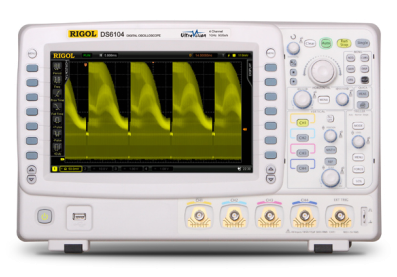ASIC (Application Specific Integrated Circuits), or special-purpose chips, are integrated circuits designed for specific applications, as opposed to general-purpose chips, such as operational amplifiers. Dedicated chips usually have the characteristics of high performance, high reliability, small size, low power consumption, etc. Especially in terms of performance, dedicated chips are often far superior to general-purpose chips. For example, an oscilloscope designed with a general-purpose chip can only achieve 1GHz bandwidth. The oscilloscope bandwidth of the dedicated chip design can reach tens of GHz, and the general-purpose chip generally cannot have the special performance of the high input impedance, low input bias current, and fast overload recovery required by the oscilloscope at the same time. Because of this, current high-performance oscilloscopes are designed with dedicated chips.
In order to develop oscilloscopes with excellent performance, on the one hand, RIGOL has continuously tapped the potential of general-purpose chips, made up for the shortage of general-purpose chips through deep analog circuit design capabilities, and launched the first commercial 1GHz bandwidth digital oscilloscope in China in 2009; In order to be able to design higher performance oscilloscopes, RIGOL began to invest in chip research and development in 2007, devoted to mastering the core technology of oscilloscope dedicated chips.

China's first commercial 1GHz bandwidth digital oscilloscope RIGOL DS6000
However, designing chips is not an easy task, especially when there is no basis for the development of the industry's advanced oscilloscope chips as the research and development goal. Designing chips that are not even available to the world's top analog chip manufacturers such as ADI and TI is like a dream. . RIGOL released the first oscilloscope ASIC chipset from 2007 to 2017, which lasted 10 years, countless sleepless days and nights, and passed through one difficulty after another. When naming the chipset, the team chose 88 constellations The Phoenix in the southern sky (Phoenix), the meaning of sustenance is "born in fire".

It takes about 2 to 3 years to develop a mobile phone SoC chip, and RIGOL takes 10 years to develop an oscilloscope chipset. Why does it take so long? First of all, there are three chips that determine the two key indicators of oscilloscope bandwidth and sampling rate, including differential probe amplifier chip, analog front-end chip, sampling and signal processing chip, which are connected in series on the system, the three together determine the oscilloscope bandwidth, so Their bandwidth performance must be balanced, otherwise it will become a shortcoming of the system. The functions and circuit structures of these three chips are very different, and they need to be developed separately.
Second, the signal frequency range measured by the oscilloscope needs to be from DC to GHz, and the measurement voltage range needs to be from mV to tens of volts. Generally, RF amplifiers have a bandwidth of several GHz or even tens of GHz, but they cannot handle DC signals, and the distortion performance is also very poor; precision operational amplifiers can handle DC and low-frequency signals from mV to tens of volts, but they cannot amplify high-frequency signals; The bandwidth of the operational amplifier can reach several GHz, but it cannot meet the requirements of mV-level DC accuracy. The characteristics of the oscilloscope's measurement signal determine that the oscilloscope dedicated chip must have the bandwidth performance of RF and broadband amplifiers, precision of precision op amps, and very low harmonic distortion. The design difficulty is self-evident.
In addition, the amplifier in the oscilloscope uses analog semiconductor technology. The current digital semiconductor technology has reached 10nm or 7nm, but the analog semiconductor technology has not yet reached this level, so it is necessary to push the ability of analog semiconductor technology to the limit through chip design. , To make up for its lack of performance. One can imagine how high this is for the chip design capabilities.
Previously, only four companies in the world were independently developing oscilloscope chipsets: Keysight, Tektronix, LeCroy, and Rohde & Schwarz. Most of them started making chips at the beginning of the birth of integrated circuits, and have decades of design experience. Since the requirements for oscilloscope chip design are so high, and RIGOL did not have any previous chip design experience, it only took 10 years to go through the journey that the previous manufacturers only completed in 20 to 30 years. How is it done? What? Please read the next article.
PROFINET, launched by Profibus international organization, is a new generation of automation bus standard based on industrial Ethernet technology. It provides a complete network solution for the automation communications sector, covering current hot topics in automation such as real-time Ethernet, motion control, distributed automation, fail-safe and network security, and, as a cross-vendor technology, it can fully compatible with industrial Ethernet and existing fieldbus technologies, protecting existing investments.
Custom Profinet,Connector M8 Profinet,M8 Connector Shielded,Profinet M8 Connector
Kunshan SVL Electric Co.,Ltd , https://www.svlelectric.com